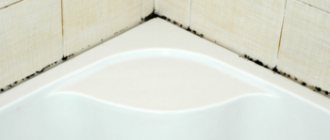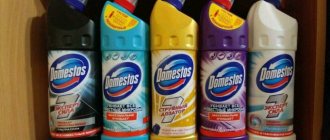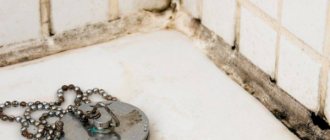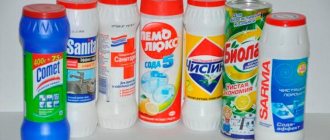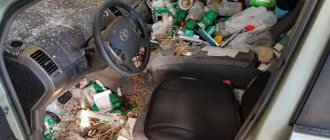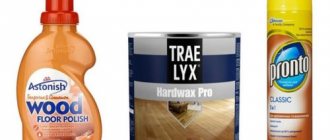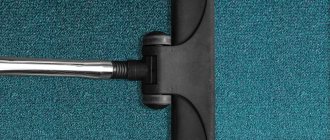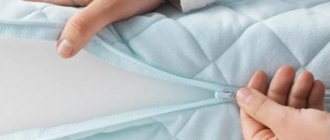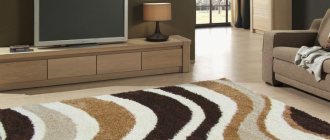Mold in the bathroom is, unfortunately, a fairly common problem. After all, warm air combined with high humidity is an ideal environment for the spread of fungus. Namely, these conditions are most often combined in bathrooms with insufficient ventilation and lack of sunlight. Unfortunately, even excellent repairs are not protection against mold. If no measures are taken to combat the spread of mold, its spores will negatively affect the health of residents. There are plenty of ways to get rid of mold in the bathroom, the main thing is not to leave even a small speck of mold unattended.
Why is mold on walls dangerous?
Mold is a colony of single-celled fungus that reproduces by spores. These microscopic spores are present in the air almost everywhere, as they are transported along with dust masses.
Bathroom ceiling covered in mold.
If the situation in the house is favorable, mold has not found a “place to settle,” then the human body does not even notice these spores in small quantities (except for people with allergies). It’s a different matter if the colony settled, began to grow, and itself turned into a constantly operating “generator” of these same spores. Then they inevitably enter the indoor air in large quantities and contribute to the rapid further development of colonies. But they begin to pose a particular danger when they enter the human body, causing a number of dangerous diseases.
- Allergic reactions are very severe and extend even to those people who were not previously affected by other allergens.
- Respiratory tract diseases. With constant inhalation of spores, a person can develop even such serious diseases as pneumonia and asthma, with the transition to a difficult-to-treat chronic stage.
- Skin diseases - dermatoses, mycoses and other lesions.
- A state of exhaustion of the body, disorders of the digestive system, nausea, dizziness and headaches are possible.
- When exposed to mold, very serious systemic disturbances in the functioning of the lungs, liver, kidneys and other organs can occur.
Fungal infections are especially dangerous for the elderly, children, and those who are already predisposed to allergic reactions. Medical statistics know many cases with fatal outcomes.
Fungal infections also cause serious damage to building structures. This should also never be forgotten. The longer the fight against this pathogenic microflora is “postponed until later,” the more difficult it will be to cope with it in the future.
Mold that appears on the surface of walls and ceilings gradually grows inside and destroys the structure of building materials. This leads to peeling of the plaster and decorative cladding.
Mold that has penetrated the structure of concrete slabs draws out the lime components from them, which dramatically increases the fragility of the material. In addition, as a result of the vital activity of the fungus, decay products are formed, resulting in internal stress. If timely measures are not taken, destruction of the surface layers of slabs or masonry may occur. Then considerable costs will be required not only for removing mold, but also for repairing walls and ceilings.
Wood that is not properly treated becomes extremely vulnerable to fungal attack.
Well, mold is completely destructive for wooden parts - it can “eat up” high-quality wood in just a couple of years. Fortunately, if we are talking only about finishing. But load-bearing parts can also be affected!
Causes of fungus
Of all the rooms, the bathroom is the most vulnerable. The climate that forms here provides favorable conditions for the development of the fungus. And if there are no characteristic dark spots in the new house or apartment, it’s just a matter of time. As soon as the humidity level rises and the functionality of the ventilation system deteriorates, the fungus will immediately make itself known. What is typical is that the type of surface does not matter - it can be either painted concrete or modern plastic.
Why does black mold appear?
The best place for mold spores to grow is the washing machine.
Mold in the washing machine
All its corners, inaccessible and damp, can be confidently called true breeding grounds for fungus. In principle, spores are constantly present in the home, but only bloom under favorable conditions.
Table. Why does fungus develop?
| Cause | Short description |
| High humidity (more than 90%) | If we talk specifically about the bathroom, there is no way to get rid of humidity unless you simply stop visiting this room. After each water procedure, condensation forms on the surfaces of the room (ceiling, walls, etc.), which contributes to the spread of fungus. |
| No antiseptic treatment | If, during finishing, you do not treat the room with special compounds in a timely manner (or do not treat it at all), then the mycelium will easily settle on the walls, in various kinds of joints (including between tiles) and other places. |
| Lack of natural light | Without windows in the bathroom, the lack of natural ultraviolet light can lead to the development of fungus. The fact is that UV rays have a detrimental effect on it. |
| Heat | If the temperature in this room exceeds +20°C, then the likelihood of fungus appearing increases significantly. |
| Poor/no ventilation | If the diameter of the ventilation opening is insufficient or the exhaust air ducts are clogged, air circulation will be disrupted. Humid air will remain in the room instead of leaving it. And this is also one of the provoking factors. |
When at least one of the listed conditions occurs, thin lines of mold mycelium appear on all wet surfaces and begin to multiply quite quickly. Almost everyone is probably familiar with the characteristic dark gray pattern, accompanied by a musty smell. If nothing is done in the early stages of fungus development, then over time the plaster, paint and other finishing layers will begin to peel off, and cracks will form on the concrete surface. After this, all consequences can be eliminated only through repairs.
Why does mold appear?
Fungus appears in the bathroom for the following reasons:
- Poor ventilation. Even a constantly closed bathroom door will not cause mold if there is good draft in the exhaust duct.
- Low temperature or changes. When moisture does not dry out, ideal conditions are created for spores to develop.
- Condensation on pipes. Most often found on cast iron.
- Leak. Leaking pipes, faucets or toilets are one of the main causes of mold.
The photo shows what fungus looks like in the bathroom
It also happens that there is no reason for the formation of mold, but it appeared in one single place - perhaps this was due to a leak in the mine. In this case, contact the management company.
What methods are there?
The most radical, but at the same time effective way is a major overhaul:
- Remove finishing materials.
- Dry the surfaces thoroughly.
- Treat the floor, walls and ceiling with an antiseptic and anti-fungal primer.
- Re-finish.
During the renovation, you should also correct the problems that caused the mold: install additional ventilation, change pipes and heated towel rails, and eliminate leaks.
But there are also less drastic methods. You can remove fungus in the bathroom mechanically or using chemicals. We will tell you which option is suitable for your specific case and which compositions will help get rid of mold in the bathroom in the following sections.
Mechanical method of removing fungus
One of the tools you will need to remove fungus mechanically is a spatula.
When black spots appear on the sealant in the joints between tiles in the bathroom or on the walls in living areas, the affected coating must first be removed. Different tools are used for this:
- putty knife;
- steel brush;
- grinding attachment (installed on the drill);
- sharp knife, etc.
To prevent the spread of spores through the air (the main method of contamination of surfaces), the cladding must be treated with water. To do this, it is recommended to use a spray bottle. If you use a sponge or rag, some of the spores will become airborne when the material comes into contact with the surface. When the fungus has already penetrated the structure of wood or concrete, the milling method is used. When the infection is severe, mold is also found on inorganic surfaces. If you plan to fight it yourself, it is important to follow the instructions:
- The surface is moistened with water from a spray bottle.
- They free load-bearing structures from cladding: wallpaper on the walls, whitewash on the ceiling, flooring. This will allow you to get to the mycelium.
- If it turns out that the mold has penetrated deeper into the structure of the material of the supporting structure, remove the layer of plaster. It is necessary to clean the wall down to the rough base - brickwork, concrete.
At the next stage, chemicals are used. However, if the preparatory work (mechanical cleaning) did not provide the required result, special means will not destroy the fungus. It will continue to develop on the adjacent site.
Chemical agents can also be used against fungus.
Mechanical mold removal
If the stains are small and located on an open, smooth surface, you can remove mold in the bathroom mechanically.
- Moisten the areas covered with spores with water - this will prevent them from getting into the air and causing new outbreaks.
- Choose the appropriate tool: knife, construction spatula, brush, sander.
- Remove the fungus along with the coating, because the spores have already gotten under the wallpaper, paint or plaster.
- Treat the surface with an antiseptic solution to prevent mold from reoccurring.
Before you start scraping off the mold, wet the areas with water using a rag or spray bottle as shown in the photo.
Larger affected areas will either have to be completely replaced (such as furniture) or reverted to a major overhaul.
Folk remedies against mold
Before the advent of special preparations, home methods were used to remove dark spots from surfaces. Some of them remove mold well, which is why they are still used today. However, in terms of effectiveness, they do not always correspond to ready-made drugs. This is partly due to the fact that they use products that have a simple composition (contain 1 component).
To achieve the required result, in most cases it is recommended to apply the substances several times: from 2 to 5. A single treatment does not help destroy pathogenic particles.
Hydrogen peroxide
Hydrogen peroxide against fungus in the bathroom.
A 3% solution is used, it can be purchased at a pharmacy. The advantages of this tool:
- ease of use;
- no odor;
- the substance leaves no traces;
- peroxide can be applied to coatings made of different materials; it does not destroy their structure, but a weak bleaching effect appears on colored surfaces.
To clean mold, you do not need to dilute the substance with water. Instructions for use:
- The product is applied to the surface where the fungus develops. Moreover, the area of this zone should be larger than the affected area.
- We need to vacate the premises for a few hours. If the lesion is weak, 15-60 minutes is enough. During this period of time the premises cannot be used.
- After a few hours, you can ventilate the room, then remove the mold using a stiff brush.
Boric acid
To clean fungus from surfaces at home, prepare a solution: 1 cup of the drug, 2 liters of water. In this case, it is recommended to first remove external manifestations of mold. The surface is first moistened with water to prevent spores from spreading through the air. Once the dark spots have been removed, a boric acid solution can be applied. To do this, use a rag or a soft sponge.
Using boric acid against fungus in the bathroom.
The product is left on the surface. After it dries, the remaining powder and emerging crystals are cleaned off with paper or another sponge. In this case, you cannot use materials that were used to remove the fungus from the surface, because in this case, infection will occur again.
It is permissible to use a less concentrated solution: 4 liters of water, 1 glass of boric acid. It is used to treat surfaces by spraying with a spray bottle. Borax can be used instead of boric acid. These are different substances that exhibit similar properties. Both are antiseptics, but borax is less effective.
Tea tree oil
Tea tree oil for fungus in the bathroom.
This product helps remove fungus, since microorganisms are sensitive to the components that make up it. It is necessary to prepare a solution: 1 tsp. essential oil, 500 ml water. The substance is sprayed over the affected surface, then the dark coating is removed.
The duration of action of the product is 12 hours. Moreover, you cannot be indoors at this time. There is no need to rinse it off after the solution has finished working.
The aroma will remain in the room for some time. In case of intensive infection, prepare a more concentrated solution: 20 ml of essential oil, 1 liter of water.
Soda and vinegar
You can use soda ash and baking soda. If mold appears on tiles and other surfaces that can withstand exposure to aggressive substances, it is recommended to prepare a solution:
- Heat water (5 l).
- Add 150 g of soda of any kind. Moreover, the desired chemical reaction will occur provided that the components are diluted with hot water.
- Vinegar essence (9% concentration) - 100 g is poured into the resulting solution.
Killing fungus in the bathroom with baking soda and vinegar.
When mixing the components, foam is formed. After obtaining the desired chemical reaction, you can apply the product to the affected surfaces. To destroy fungus that has spread extensively along the wall/ceiling or floor, you need to carry out repairs - this is a radical method, but thanks to it mold is destroyed forever. First, remove the plaster, then sprinkle the area with soda and spray with concentrated vinegar.
Aqueous ammonia
This product can be applied to surfaces that do not have porosity, such as the joints of ceramic tiles in the bathroom. To improve the properties of aqueous ammonia, glycerin is added. Apply the substance using a rag or sponge. Care must be taken when doing this, as aqueous ammonia is toxic. After treatment, you need to leave the room for 1 hour. Then the remaining product is washed off from the surfaces.
Copper sulfate
The best way. It is distinguished by a significant impact on pathogenic particles. Prepare a solution using 100 g of copper sulfate (copper sulfate), 10 liters of water. If the affected area is small, the number of components is proportionally reduced. Use a brush for application. It is recommended to treat an area ¼ or 1/3 larger than the area where the fungus is developing. After a few hours, ventilate the room, wash off the solution, and along with it the fungus.
The effectiveness of using copper sulfate against fungus.
Chlorine bleach
Any product containing chlorine can be used. To destroy the fungus, Belizna and Domestos are suitable. A concentrated product is applied to the affected areas. A rag is used for this. Cleaning silicone (tile joints) is carried out with an aqueous solution based on a chlorine-containing agent. The ratio of components is 1:1. Use a spray bottle for spraying.
Professional methods of fungus destruction
For this purpose, concentrated preparations are used, which are highly effective in combating mold and other pathogenic particles. For comparison, if you use folk remedies, you will need to apply the substance many times. Professional methods allow you to destroy the fungus in 1-2 approaches. Such preparations are produced in the form of concentrated liquids. With their help, a solution is prepared or the substance is applied undiluted.
Sanitation and ionization of the room
The purpose of the measures is to destroy mold. To do this, ionized air is used, it is supplied under high pressure towards the affected surfaces. The advantage of this method is the absence of an unpleasant odor. The product is non-toxic; after treatment there is no need to rinse off the substance.
There is a detrimental effect of silver ions on pathogenic particles: fungus, bacteria, etc. The disadvantage of the method is the need to use special equipment, which is expensive. For this reason, it is necessary to invite specialists to process the housing.
Household chemicals
Designed to effectively remove fungus, household chemicals can clean contaminated surfaces several times faster than any folk remedy.
If you are not allergic to the components of antifungal drugs and there are no pets in your apartment, then feel free to use special anti-mold chemicals.
"Belizna" - chlorine-based solution
The most famous and inexpensive product called “Whiteness” for 50 rubles. Excellent removes mold stains from various surfaces.
Spraying a bleach solution onto a whitewashed ceiling will remove mold stains and stop mold growth.
To prepare the solution:
- Bleach is diluted with water in a ratio of 1 to 10.
- Apply it to a cleaned surface and wait for it to dry.
The disadvantage of this product is the specific smell of chlorine.
Oxygen bleach
It is based on sodium percarbonate , which can cope with different types of mold.
This product is well suited for removing stains from colored surfaces. With its help, you can remove fungus from curtains in the bathroom, remove black stains from tile joints, curtains, etc.
There is a large selection of such bleaches on sale. The most famous:
- "Bos Plus" costs about 30 rubles;
- “Sano Oxygen”, it can be bought for 280-300 rubles;
- “Vanish Gold” for 140-150 rubles.
Special antifungal
They are distinguished by their speed of action and efficiency . Thanks to it you can clean:
- plumbing;
- shower cabin;
- tiles
Cleaning surfaces will take from 10 minutes to an hour . Example:
- “Cillit Bang”, price 150-170 rubles;
- spray “Unicum”, costing about 180 rubles;
- “Turbo”, priced at 300-350 rubles.
Important points of the process
Let’s immediately make a reservation that you should get rid of not the visible signs of damage, but directly from the source of the problem. The visible part is dark spotting, and the focus is the mycelium (the latter is what needs to be removed). Look for the hearth not on the surface, because it is often hidden deeper, in a more humid and less lit place - in various voids, under the finishing material.
To remove a layer of mold mycelium, use a regular scraper - scrape off the affected areas with it.
Spatula-scraper
Also clean the seams between the tiles if they are damaged and remove all grout.
Removing grout from tile joints
If the tile is about to fall off, it means that a breeding ground is also hidden in it - remove it and treat the exposed surfaces.
How to remove tiles in the bathroom
All further actions must be carried out in a dry room. For this reason, arm yourself with a hair dryer (it’s convenient for heating cleaned areas) or, if you don’t have one, use a regular household heater.
General appearance of a construction hair dryer with its names of individual parts
After drying everything, start fighting the fungus using special means (more on them later). It is very important to comply with safety requirements, so use protective equipment when working.
Protective means
Dose the selected drug in accordance with the manufacturer’s instructions (or one of those presented in this article).
The last step of the work is to reheat the room.
Products used for repair work
To avoid mold contamination of walls for a long time, builders use highly effective fungal repellents.
Copper sulfate and special primers or emulsions applied to the wall will not only completely destroy the fungus that appeared before the repair, but will also prevent its reproduction in the future.
Let's take a closer look at how these tools work:
How to remove mold stains with copper sulfate?
This is one of the most effective remedies for fungus. Copper sulfate, which can be bought for 150 rubles, can protect walls from mold for a long time.
To treat surfaces, dilute the following solution:
- take 100 gr. vitriol;
- 10 liters of water.
Apply the product to the wall with a brush . In places where the fungal infection is very strong, the wall is covered with a solution in several layers.
When 3-4 hours have passed, the wall is washed and dried.
Copper sulfate must be handled very carefully because this product is very toxic. When working with it, you need to ventilate the room well, and also use a respirator and gloves.
Antiseptic emulsions
These drugs include antifungicides that protect against biocorrosion. They are made on the basis of QAC (quaternary ammonium compounds) and guanide.
For the bathroom, Renogal is suitable for 360 rubles, which can remove mold even from the seams between the tiles.
The following tools are also popular among users:
- antiseptic “Abedis 06 Barwa Sam” for 250-300 rubles;
- “Snowball Puma” for 80-100 rubles;
- emulsion “Alpina Ground” for 300-350 rubles.
Primers
Before using these products, you need to prepare the surfaces. A layer of whitewash or paint is removed from the walls and ceiling, and the plaster is dried using a hair dryer.
You need to work in a respirator so that mold pores do not enter the respiratory tract.
The finished walls and ceiling are treated with an antifungal emulsion or other product.
Among the popular means:
- “Ceresit CT-99” antifungal primer costing 360-400 rubles;
- primer "Caparol Capatox" for 650-700 rubles;
- "Bairis BioStop" for 200-250 rubles.
Fungus on wooden surfaces
The most difficult thing to remove is fungus that has grown on wood surfaces. And if you notice cotton-like formations, remove them immediately and treat the areas with a special solution. If the wooden parts are badly damaged, replace them.
Fungus on wood - photo
A 3% solution of potassium fluoride is quite effective. You can dilute it in water (20 g per 1 liter), mix thoroughly and apply the resulting product to the affected areas.
Getting rid of mold using specialized products
In the assortment of specialized stores, it is easy to choose antiseptic compositions aimed at combating fungus in the bathroom:
- The “Antifungal-Anti-Mold” product presented can be used to treat surfaces as a primer during repairs. And they also add it to whitewash or water-based paints. If you are deciding how to remove fungus in the bathroom without dismantling the finish, then you should treat all stains with a brush or roller.
- Antiseptics from the “Isocide” series of the Ukrepservice enterprise allow you to fight mold on various materials, destroying other harmful microorganisms that can be found in the bath.
- It is important to know how to remove fungus in the bathroom using means that are safe for health. For example, latex emulsion “MIL KILL”, produced by. It is often used during repairs as a preventive primer, although if necessary, you can use it to clean any hard-to-reach places where dark spots are noticed.
- Allows you to get rid of black mold in the bathroom with the universal antiseptic “DALI”, offered by JSC NPP Rogneda, sold in finished form.
Many people, faced with the problem of how to destroy fungus, turn to time-tested solutions. An example is copper sulfate (100 g of powder is diluted in 10 liters of water). Apply it to all surfaces, after wearing gloves and a respirator. Then the areas with obvious mold infestation are coated again. After 7–8 hours, the treated surface is washed, dried, and the room is ventilated.
Another well-known composition for removing black mold in the bathroom is chlorine bleach, which is added to water in a ratio of 1:10. When working, you need a respirator and rubber gloves. If you get rid of fungus in this way, then there is no need to wash off the applied product, but the room should be thoroughly ventilated.
Armed with the knowledge of how to remove mold in the bathroom, it is advisable to use the preparation “Renogal” (Germany) to treat the seams, which will preserve the lining. If fungal colonies are removed with a solution of bleach or copper sulfate, then after washing them off, the joints are coated with a sealant.
Before you fight to keep surfaces free from fungus and make a purchase, you need to study information about antiseptics in order to choose the variety that is suitable for your specific conditions.
Safety rules for withdrawal
When removing mold in the bathroom, follow safety precautions:
- Wear gloves, safety glasses and a respirator when working with any product - be it soda or copper sulfate.
- Cover clean surfaces with film to prevent spores from getting on the floor or furniture.
- Remove as many things and furniture as possible from the room.
- Turn off the hood and avoid drafts; black mold in the bathroom can easily spread through the air.
- Throw away everything you used during the process: rags, brushes, film, gloves, respirator and goggles.
Before starting work, put on a mask and gloves, as in the photo
If you see mold in your bathroom, take immediate action to eliminate it. And then follow practical rules of prevention to prevent new colonies from developing.
Preventing mold in the bathroom
Prevention prevents the reappearance of fungus indoors. Important:
- Find out the correct location of the ventilation ducts. If necessary, call a specialist. He will conduct a professional inspection and report on the operation of the ventilation.
- After using the shower or bath, wipe the walls with a towel, removing excess moisture. Leave the door open.
- Be sure to use the kitchen hood when cooking or boiling water.
- Avoid growing indoor plants: geraniums, violets. They cause mold.
- When repairing walls, use a primer treatment. It prevents the appearance and spread of fungus.
- Insulate the walls in the apartment. Especially on the north side. You can use special impregnation during work.
- If cracks appear in the walls, they must be sealed. Carefully check the baseboards for drafts. Frequent temperature changes in the apartment are not allowed.
- Buy devices that absorb moisture. Place on all windowsills.
When fungus appears on the walls, tiles, bathrooms, or under the sink, it is important to do some work.
There are many types of mold, but if you eliminate it in time, there will be no consequences. Fungus is removed using chemical and folk remedies.
No antifungal grout will help if there are suitable conditions for the formation of fungus and mold
In advanced cases, the affected areas are often replaced. Chemicals will not help if the fungus is deeply embedded. Prevention is necessary. Then the mold will not affect the apartment premises.
Tips for preventing fungus
Once you have removed black mold, it is important to prevent it from forming again. To do this, use preventive tips:
- Prime the walls. Do not neglect this important step, because the soil not only promotes high adhesion, but also prevents the development of fungus.
- Repair the ventilation. If there is not enough draft in the shaft, install an electric hood and open the doors more often.
- Take care to maintain the temperature 23-25C. Replace your heated towel rail with an electric one or install a heated floor system to maintain warmth at any time of the year.
- Remove sources of dampness. Insulate pipes, fix leaks, and replace plumbing if necessary.
- Take care of waterproofing. Treat the edges of the bathtub or shower with sealant, and cover the walls with moisture-resistant enamel.
- Replace furniture. If the cabinet or cabinet was standing next to an infected wall, you can rest assured that black mold spores are already deep in the material. They penetrate especially easily into chipboard and MDF. Destroy items for your own good.
- Wash the walls and ceiling. Most often in the bathroom we only clean the floor and fixtures. But weekly wet cleaning of all surfaces with a disinfectant is an effective preventive measure.
After wet cleaning, wipe the surfaces dry with an absorbent cloth as in the photo.
- Wipe the bathtub and sink until dry. Get a special towel that you will use to wipe the shower tray or bath bowl after water procedures.
- Wash curtains and rugs once a month. You will feel more comfortable in the bathroom with clean textiles, and this will also help kill fungal spores.
- Dry bath towels outside the bathroom. Especially if the room is small and not warm enough.
